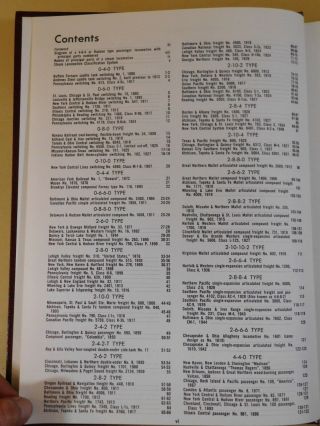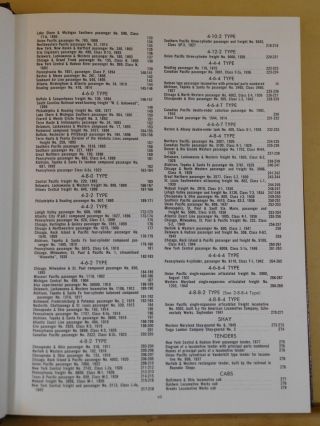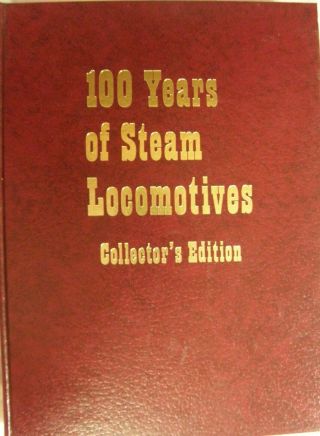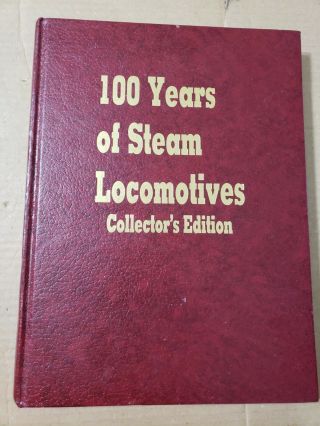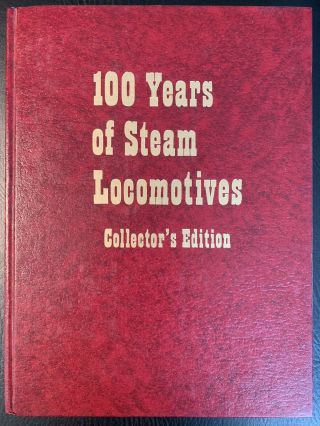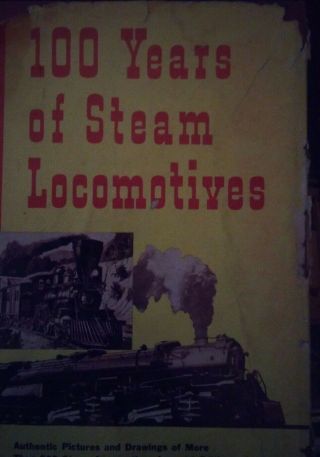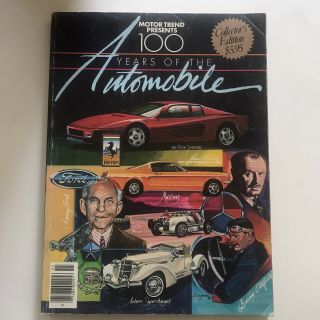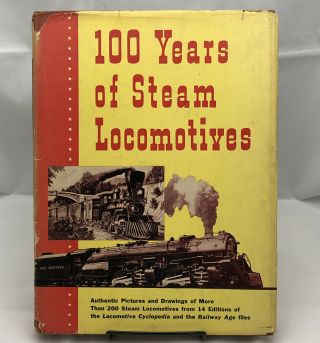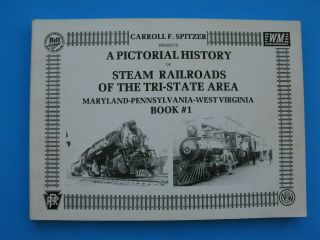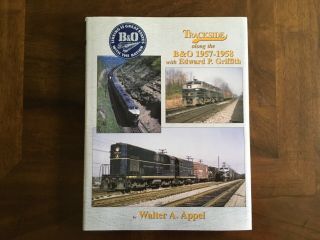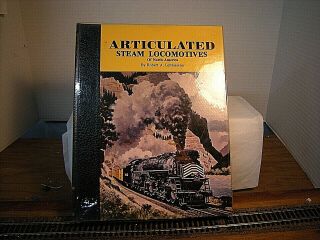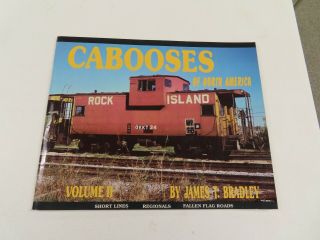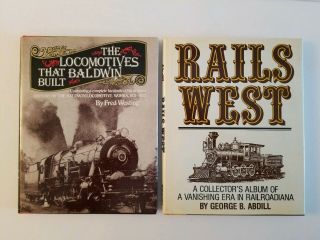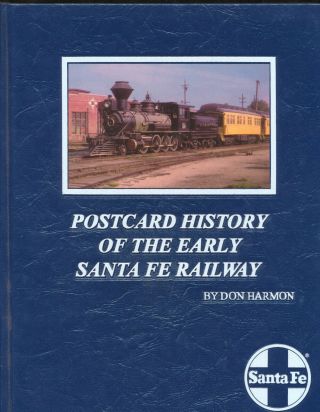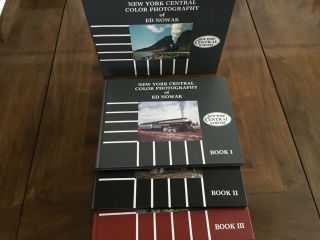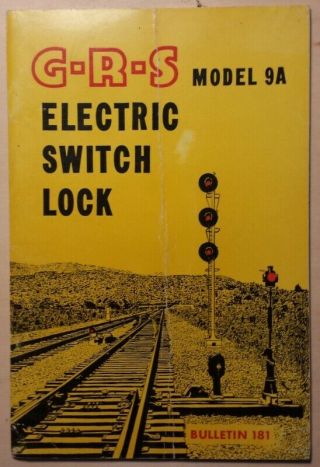100 Years Of Steam Locomotives Collector ' S Edition By Walter Lucas HArd Cover
Item History & Price
| Reference Number: Avaluer:17721530 |
RailroadTreasures offers the following item: 100 Years of Steam Locomotives Collector's edition By Walter Lucas HArd Cover 100 Years of Steam Locomotives Collector's edition By Walter A Lucas 277 Pages Hard Cover. Copyright 1957, 1981 Simmons-Boardman Publishing. Foreword --ONE hundred Years of Steam Locomotives can be termed a continuation of the Popular Picture and Plan Book of Railroad Cars and Locomotives published in 1951 and the... Pocket Guide to American Locomotives published in 1953. These hooks proved to be very popular, especially with model builders and railroad hobbyists in general.The growing demand for further information, diagrams, and illustrations of the rapidly disappearing steam locomotive prompted the publication of this volume which includes many of the foregoing and also those of other bygone eras, As in the previous books, the illustrations have been taken from past issues of the Locomotive Cyclopedia and its predecessors, namely the Locomotive Dictionary. Modern Locomotives, Recent Locomotives, Railway Aye, and The Railroad Gazette, all publications of Simmons-Boardman, plus a few similar examples of locomotives obtained from other sources.Primarily intended for use of steam railroad model builders, the illustrations were selected for their clarity in reproduction so that anyone familiar with the use of a simple scale can readily recreate a desired type of locomotive in miniature. in nearly all examples the elevation drawings have sufficient dimensions that can be measured and divided into their proper scale components. This can conveniently be done by marking along the edge of a straight piece of paper the desired dimension taken from the elevation drawing and dividing the line into the number of feet shown. By subdividing the end portion into 12 equal parts a reasonably good scale will result, enabling the model builder to lay his improvised scale upon any undimensioned part of the drawing and obtain a direct reading in feet and inches. If the elevation drawings, cross sections, and photographs are carefully followed, a capable model builder should be able to reproduce a miniature locomotive closely resembling the original illustrated in the book and with better results than is generally found in amateur model-building work. The various types of steam locomotives are grouped according to wheel arrangement, beginning with the supplest in the Whyte system, and the different individual locomotives under a particular wheel arrangement category are shown in chronological order. Numerous model builders have requested plans of the 4-4-0 type of locomotive which for many years was the standard type used in both freight and passenger service in the United States. It is known as the Eight-Wheel or American type and we have included a variety of them dating from 1856 to 1914. Steam locomotive construction for domestic use came to a complete halt in 1949 because of the replacement of steam motive power by diesel-electric locomotives. Most of the modern types of steam locomotives still in use are modifications of older types with the substitution of four-wheel for two-wheel trailing trucks. In early types, the firebox was suspended between the engine frames, and, being limited by the frame clearances, necessarily was narrow and practically governed the grate area obtainable. About the year 1881 some locomotives were built having the fire-box foundation rings raised to the top of the frames and widened to occupy the entire width between the driving wheels. This made possible a substantial increase of grate area and heating surface which added to the steaming capacity of the boiler. The Wootten type boiler with a large grate area for burning anthracite was introduced on the Philadelphia & Reading in 1878. At the present time little anthracite is burned in locomotives.About the year 1893 a locomotive was built with the firebox in back of the rear driving wheels and widened to extend the full width of the locomotive, the resulting increase in firebox length being accommodated by carrying the rear end of the locomotive frame 011 a trailing truck having small-diameter wheels entirely below the foundation ring. With this type of construction, firebox dimensions were Iimited only by the railway line clearances and by the ability of the fireman to shovel coal; the tubes were lengthened, greater heating surfaces were obtained, and the size of locomotives was greatly increased. A further advance took place in 1925 when the four-wheel trailing truck was developed.In later years, the tendency was to obtain greater capacity and efficiency by refinement in design and by the perfecting of such appliances as superheaters, mechanical stokers, and feedwater heaters. Improved combustion, a better proportioning of the boiler to steam demands, higher steam pressure and greater superheat, together with better locomotive utilization and train operation, coupled with longer runs, brought about a marked reduction in the average amount of coal consumed per 1.000 gross ton-miles.A secondary engine-known as a "booster"-was developed for use on locomotives having two- or four-wheel trailing trucks. The booster was applied to a truck axle and provided additional tractive force that assisted the main engines in starting heavy trains and when traveling up steep grades.The slide valve type of engine was in common use until about 1900 when the piston valve was introduced in locomotive design. The piston valve is the one now in general use. In American practice, steam locomotives are invariably provided with single-expansion cylinders, the only exception being some Mallet articulated compounds in slow, heavy freight service. Other classes of compound locomotives were extensively used 55 years ago. These were of the two-cylinder, cross-compound variety and four-cylinder compounds having cylinders superimposed or arranged in tandem.Many different types of locomotives have been built but several which proved to be the most efficient became standard in America. These types, varying on the different railroads in details of construction, are of three general classes: freight, passenger, and switching locomotives.Locomotive InventoryThe rapid decline in the total number of steam locomotives in the United States is shown by the following figures. At the beginning of the year 1956, there were 6, 266 steam locomotives owned by all railroads and by the first of April 1957 this had dwindled to only 3, 437 in service. Likewise in Canada the total number of steam locomotives was 3.225 at the beginning of 1956 and this has dropped considerably in the meantime.Freight LocomotivesFreight locomotives generally have a two-wheel leading truck to help support the front end and guide the locomotive around curves. The truck is located under the forward end of the boiler. Driving wheels, formerly of a relatively small diameter, usually 63 inches or under are now larger. The rear end of the boiler and the firebox are either supported on a separate rear frame or cradle carried on a trailing truck, or, when without trailing trucks, on an extension of the frames. The large proportion of the total weight resting on the driving wheels provides the adhesion necessary for the large tractive force required to haul today's long, heavy trains. Most modern freight locomotives, owing to increased speeds, have driving wheels of 69 inches or 70 inches diameter.Locomotives commonly included in this class, that were in general use in North America, are Consolidation-2-8-0; Mikado-2-8-2; Berkshire-2-8-4; Decapod-2-10-0 ; Santa Fe-2-10-2 ; Texas-2-10-4; and various articulated types. Pacific type-4-6-2; Mountain type-4-8-2, and the 4-8-4 type, all originally designed for passenger service, were also used for fast freight. The 2-6-0-Mogul type locomotive was introduced in 1863 following the invention of the Bissell truck. This wheel arrangement became quite popular but very few locomotives of the Mogul type are now in use. The 2-6-2-Prairie type locomotive was first built in 1900 for freight service on the Chicago, Burlington & Quincy. It was simply a Mogul with a pair of trailing wheels added under the firebox. This arrangemnet permitted the use of a wide firebox having a relatively short length but gave a large grate area. It permitted easy hand firing which was not possible with the extremely long firebox of the earlier narrow type.The 2-8-0-Consolidation type is the logical step after the Mogul type, having an additional pair of driving wheels and consequently greater hauling capacity. It was first constructed in 1866 for the Lehigh Valley and is still used on some railroads in light freight service.The 2-8-2-Mikado type was developed from the 2-80 type, having the same number of driving wheels and, in addition, a two-wheel trailing truck under the firebox. This arrangement gives the advantages of a wide firebox in conjunction with a large boiler the resulting high steaming capacity permits a more sustained use in heavy service. This type was first built in 1897 for use in Japan, from whence the name Mikado was derived.The 2-8-4-Berkshire type was an evolution from the 2-8-2 type, having the same number of driving wheels but with a four-wheel instead of a two-wheel trailing truck. This wheel arrangement permitted a better boiler design with a larger grate area. It was used first on the Boston & Albany in 1925, having been designed by the Lima Locomotive Works, Inc.The 2-10-0-Decapod type locomotive, first built by Norris Locomotive Works for the Lehigh Valley in 1867, is similar to the Consolidation type except that it has an additional pair of driving wheels. This permitted the use of a still larger boiler and provided greater adhesion and tractive force. This type is well adapted for heavy drag freight service and is extensively employed on the Pennsylvania Railroad.The 2-10-2-Santa Fe type was a step forward from the 2-10-0 type in the direction of heavier motive power. It has a pair of trailing wheels which provide for a greater length of boiler and firebox, with the result that greater steam capacity and tractive force is obtained. This type was first built in 1903 for use on the Atchison, Topeka & Santa Fe and for that reason was designated the "Santa Fe" type.The 2-10-4-Texas type was an evolution from the 2-10-2 type, having the same number of driving wheels but with a four-wheel instead of a two-wheel trailing truck. This wheel arrangement permitted a better boiler design with a larger grate area. It was first used on the Texas & Pacific in 1925, and like the 2-8-4 type was designed by the Lima Locomotive Works, Inc.Articulated LocomotivesArticulated locomotives were built as early as 1832. The Mallet articulated compound locomotive, introduced in Europe in 1887, was not built in the United States until 1904-an 0-6-6-0 type used in heavy freight service on the Baltimore & Ohio. This type has two sets of frames-rear frames held rigidly in alignment with the boiler, and front frames connected to the rear unit by a pivot joint. Each set of frames is carried on a separate group of driving wheels-four, six, eight, or ten, depending on the size of the locomotive. Usually the front frames support the forward end of the boiler on sliding frame bearings that allow the leading unit to swivel radially about the pivot connection, giving the effect of a truck. These features make possible a locomotive with a short rigid wheelbase and moderate wheel loads but having large tractive force. Some articulated locomotives have been built with the leading unit as well as the rear unit rigidly secured to the boiler, the swiveling effect being obtained by means of an articulated or flexible boiler.When the engine is of the compound design - the real Mallet arrangement-the rear group of wheels is driven by high-pressure cylinders mounted on the rear frames at the leading drivers. The front group is driven by low-pressure cylinders mounted at the leading drivers of the group. Steam from the boiler enters the high-pressure cylinders, is exhausted through a flexible pipe connection to the low-pressure cylinders, where it further expands and then is exhausted to the front end and thence to the atmosphere. This system of cormpounding was first proposed by Anatole Mallet, a native of Switzerland, from whom this type of locomotive takes its name.A few articulated compound locomotives having three pairs of cylinders and three groups of drivers-known as Triplex-have been built for very heavy freight service. The third group of drivers was located tinder the tender two cylinders were high-pressure and four were low-pressure, the high-pressure pair driving the middle group of wheels. The right high-pressure cylinder exhausted to the front pair of low-pressure cylinders; the left high-pressure cylinder supplied the rear pair of low-pressure cylinders in a similar manner. This arrangement did not prove entirely satisfactory because the extremely high steam capacity needed was not easily obtained.Articulated locomotives now in service on American roads are invariably of the single-expansion type, the compound features having been done away with and four high-pressure cylinders employed. This arrangement permits operation at higher speeds and reduces the cost of maintenance. A number of roads have converted existing articulated locomotives from compounds to single-expansions. While most single-expansion articulated locomotives are used in freight service, some are used in heavy passenger service where there are heavy grades.Passenger LocomotivesPassenger locomotives, or those provided with a four-wheel leading truck to give greater security in rounding curves at the high speeds attained in modern passenger service, have two, three, or four pairs of driving wheels of large diameter, generally 69 inches to 84 inches. On many locomotives of earlier construction the rear frame supporting the firebox was carried on a two-wheel trailing truck, although later ones were built with four-wheel trailing trucks. The types included in this class used on American railroads are: Atlantic-4-4-2, Hudson-4-6-4, Pacific-4-6-2, Mountain-4-8-2, and Northern -4-8-4 type. The last three types are also often used for fast freight service. Ten-wheel-4-6-0 and some eight-wheel or American-4-4-0 passenger locomotives are also still in use on a few railroads. Other types, introduced in 1925 and 1926, were the 4-10-2 and 4-12-2 types, for both freight and passenger service.The 4-6-0 type was introduced on the Philadelphia & Reading in 1847 and the first 4-8-0 type on the Baltimore & Ohio in 1856. This 4-8-0 type was intended for passenger service but subsequently nearly all locomotives with this wheel arrangement were built to haul freight trains.A few passenger locomotives having a single pair of driving wheels, called the Bicycle type, have been built, but as they were generally lacking in tractive force they were rebuilt into other types where they could perform more satisfactorily.The 44-2-Atlantic type locomotive first appeared in 1888 when one was built to George S. Strong s patents and used in high-speed passenger service. As developed later, this type was a modification of the 2-42-Columbia type built in 1893 and the earlier eightwheel-4-4-0-locomotive, first built in 1837. The latter for many years was standard on American railroads for both passenger and freight service and thus became known as the American type. The term "Atlantic" was derived from the fact that the 4-4-2 type was extensively used on the Atlantic Coast Line in 1895.A further development produced the 4-4-4-Readingtype of which a few were built in 1915 for the railroad bearing that name. This type never came into general use.The 4-6-2-Pacific type locomotive is a development from the 4-4-2 type, simply having three pairs of driving wheels instead of two, and consequently a larger boiler and firebox with the attendant increase in steam capacity and higher tractive force. A locomotive with this wheel arrangement was built by George S. Strong in 1886 and used for a while on the Lehigh Valley. The next one was in 1901 by Baldwin Locomotive Works for some locomotives for New Zealand, followed in 1902 by some built by American Locomotive Company for the Missouri Pacific, hence the name. This type was used extensively in passenger service and many times in fast freight service.The 4-6-4-Baltic, or Hudson, type was an evolution from the 4-6-2 type. It was first built in France in 1913 and introduced into the United States on the New York Central in 1927, having been designed by the American Locomotive Company.The 4-8-2-Mountain type locomotive was first built in the year 1911 and used in passenger service on the mountain grades of the Clifton Forge Division of the Chesapeake & Ohio, hence the name. It was designed to provide a greater tractive force than could be obtained from the Pacific type and is similar to it but has an additional pair of driving wheels. The use of a very large boiler and firebox provides a high steam capacity.The 4-8-4-Northern type, an enlargement of the Mountain type, was first constructed in 1926 for the Northern Pacific, from which it takes its name. It was closely followed in 1927 by others for the Canadian National, Grand Trunk Western. Atchison, Topeka & Santa Fe, and Delaware, Lackawanna & Wester, Locomotives of this type have since been built for many other roads for use in both passenger and fast freight service.Switching LocomotivesSwitching locomotives were designed for varied service that required a machine so proportioned that it would readily pass over the relatively sharp curves encountered in railroad yards. would start in either direction easily and quickly, and possess ample tractive force to move heavy loads. To accomplish this the modern switching locomotive had its entire weight resting on the axles of driving wheels of comparatively small diameter. Thus it secured the maximum amount of adhesion and tractive force from a given total weight of locomotive. The cylinder area and steam capacity was as great as consistent with the size of the locomotive. The wheel arrangement of this class of motive power consisted of six or eight drivers, classified as 0-6-0 and 0-8-0 types respectively. Some very heavy units having ten drivers-0-10-0 or 0-10-2-have been built. For light service, chiefly in the yards of industrial works, switchers having only four drivers, 0-4-0, were used.The switching locomotives generally used in railroad yards were equipped with 8-wheel tenders. Sometimes these were made with a sloping rear end so that the engineman could have an unobstructed view to the rear as well as ahead of the engine. Many of the smaller switchers, 0-4-0, had fixed tenders built on the back of the cab. Sometimes this tender rested on an extension of the frames but more often
All pictures are of the actual item. If this is a railroad item, this material is obsolete and no longer in use by the railroad. Please email with questions. Publishers of Train Shed Cyclopedias and Stephans Railroad Directories. Large inventory of railroad books and magazines. Thank you for buying from us.
Shipping chargesPostage rates quoted are for shipments to the US only. Ebay Global shipping charges are shown. These items are shipped to Kentucky and then ebay ships them to you. Ebay collects the shipping and customs / import fees. For direct postage rates to these countries, send me an email. Shipping to Canada and other countries varies by weight.
Payment options Payment must be received within 10 days. Paypal is accepted.
Terms and conditions All sales are final. Returns accepted if item is not as described. Contact us first. No warranty is stated or implied. Please e-mail us with any questions before bidding.
Thanks for looking at our items.
00265




